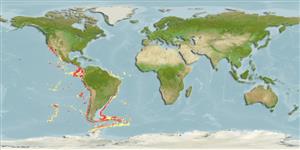Common names from other countries
Classification / Names / Names
Common names | Synonyms | Catalog of Fishes (gen., sp.) | ITIS | CoL | WoRMS
Malacostraca >
Decapoda (Lobster, shrimp and crabs) >
Lithodidae (stone and king crabs) > Lithodinae
Environment: milieu / climate zone / depth range / distribution range
Ecology
Benthic; depth range 200 - 2454 m (Ref. 2686). Deep-water; 37°N - 73°S, 124°W - 23°W
Eastern Pacific, Southwest Atlantic and the Antarctic: Gulf of California to Scotia Sea.
Length at first maturity / Size / Weight / Age
Maturity: Lm ? range ? - ? cm Max length : 13.7 cm CL male/unsexed; (Ref. 2690); max. published weight: 1.0 kg (Ref. 2690)
Minimum depth from Ref. 113901. Found on hydrothermal vents (Ref. 2682). Scavenger (Refs. 2682, 106711) feeding on the infauna of the abyssal plain (Ref. 2682). Carries on its back commensal amphipods, mostly gammarids (Ref. 106711).
Life cycle and mating behavior
Maturity | Reproduction | Spawning | Eggs | Fecundity | Larvae
Members of the order Decapoda are mostly gonochoric. Mating behavior: Precopulatory courtship ritual is common (through olfactory and tactile cues); usually indirect sperm transfer.
Macpherson, E. 2004. (Ref. 2686)
IUCN Red List Status (Ref. 130435)
CITES status (Ref. 108899)
Not Evaluated
Not Evaluated
Human uses
Fisheries: commercial
| FishSource |
Tools
More information
Age/SizeGrowthLength-weightLength-lengthMorphologyLarvaeAbundance
Internet sources
Estimates based on models
Preferred temperature
(Ref.
115969): 1.9 - 4.5, mean 3.4 (based on 159 cells).
Vulnerability
Low vulnerability (10 of 100).
